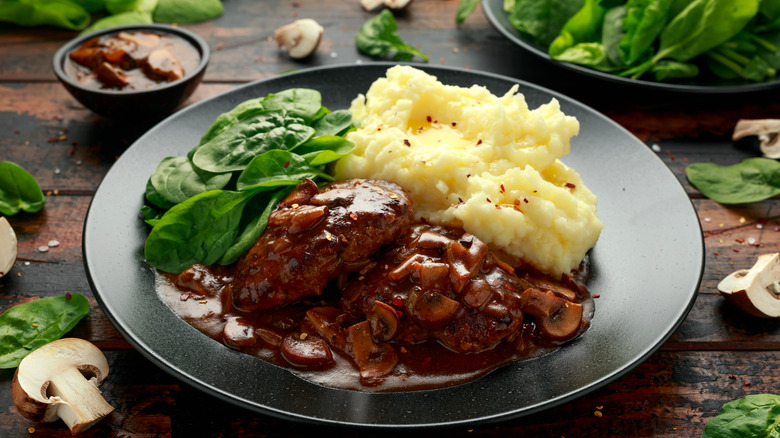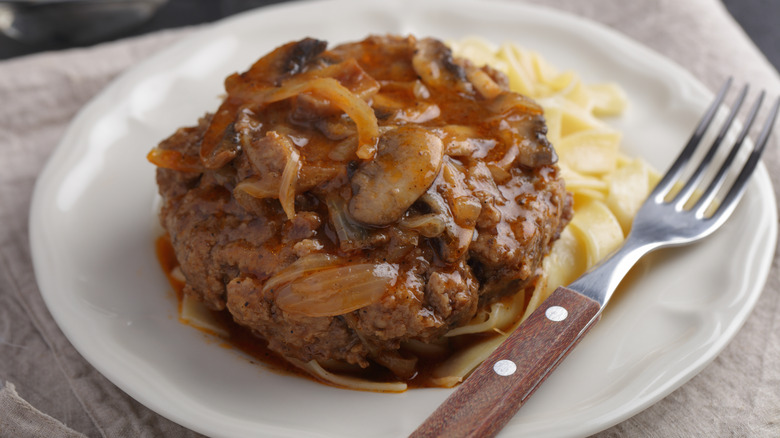Is Salisbury Steak Actually Considered Steak?
Salisbury steak may sound like it has origins in Salisbury, England, or Salisbury, North Carolina, but the truth is that it was invented by American physician James Salisbury in the 1800s. In fact, Salisbury created his steak as a way to get proteins into Union soldiers during the Civil War, as meats and other proteins were a rare, if outright excluded, part of the soldier's diet. Salisbury steak was meant to be a cheap, quick, and nutritional meal, something that would provide nutritional and digestive benefits to battle-weary soldiers.
Following the Civil War, Salisbury steak entered the American diet, both as a diet fad and a regular meal. In the 1950s, as the TV dinner swept the nation, the steak gained new popularity as a fast pre-made dinner. From TV dinner trays to hospital food, Salisbury steaks soon became a symbol of a classic American comfort dinner, soaked in onions, mushrooms, and gravy. That's why it may surprise you, then, to learn that Salisbury steak isn't a "real" steak. In fact, you would probably be better off calling it a "Salisbury hamburger patty" than anything related to a porterhouse or a filet mignon.
But what exactly do we mean by Salisbury steak not being a "real" honest-to-goodness cut of steak? How is it made, and why do we say it has more in common with hamburger patties than anything related to cuts of steak?
Salisbury steak is a cross between a hamburger and meatloaf
You may notice that, among the usual ranking of steak types like filet, sirloin, or t-bone, you'll notice that nowhere in any list is Salisbury steak isn't mentioned anywhere. That's because Salisbury steak isn't actually a real steak in the sense of it being a whole cut of meat. Instead, it helps to think of Salisbury steak as being a cross between a hamburger and meatloaf, as it is basically just ground beef shaped together.
While a Salisbury steak may sound like another version of meatloaf, considering both dishes are ground beef mixed and formed into different shapes, the key difference is how both dishes are prepared. Meatloaf takes a mixture of ground beef, breadcrumbs, onions, and other fillers and forms it into the shape of a bread loaf. This "loaf" is then baked in the oven and topped with a sweet, tangy glaze made up of ketchup or tomato paste. Salisbury steak, on the other hand, is prepared by taking that same mixture shaping the meat into a patty, and then grilling or browning it in a pan. The cooked patty is then covered in onions, mushrooms, and brown gravy.
In short, although Salisbury steak may be called a "steak," it's actually more similar to a hamburger patty. It differs from meatloaf not just in cooking methods, but also in ingredients and shape.
Salisbury steak also differs from hamburger steak
If you've ever been to a diner before, chances are you've probably seen something on the menu called "hamburger steak." You may think that, since a Salisbury steak is similar to a hamburger patty, this is just another name for it. While it is true that Salisbury steak and hamburger steaks are similar in some ways, they're not exactly the same.
A hamburger steak is said to have a much thicker texture, usually made up solely of ground beef, salt, and pepper. A hamburger steak also has a meatier flavor to it, being much less firm and more "loose" than that of a Salisbury steak. When you cut into a hamburger steak, it may fall apart in your fork similar to how cutting into a traditional hamburger patty. On the contrary, a Salisbury steak is much more firmly packed with a variety of different fillers and seasonings, has a thinner texture, and has a much more robust flavor than a hamburger steak.
For a brief time, Americans preferred the Salisbury steak over the hamburger steak. During World War I, when anti-German sentiment was high, Americans vetoed the hamburger steak (or the "Hamburg" steak, as it shared a name with the popular German city) in favor of the Salisbury steak, which was viewed as the "patriotic" choice over the latter. At the end, while both "steaks" share similar qualities, they mainly differ in texture and aren't exactly the same item.


